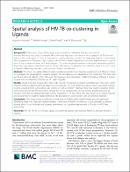| dc.description.abstract | Tuberculosis (TB) is the leading cause of death for individuals infected with Human immunodeficiency virus (HIV). Conversely, HIV is the most important risk factor in the progression of TB from the latent to the active status. In order to manage this double epidemic situation, an integrated approach that includes HIV management in TB patients was proposed by the World Health Organization and was implemented in Uganda (one of the countries endemic with both diseases). To enable targeted intervention using the integrated approach, areas with high disease prevalence rates for TB and HIV need to be identified first. However, there is no such study in Uganda, addressing the joint spatial patterns of these two diseases.
Methods
This study uses global Moran’s index, spatial scan statistics and bivariate global and local Moran’s indices to investigate the geographical clustering patterns of both diseases, as individuals and as combined. The data used are TB and HIV case data for 2015, 2016 and 2017 obtained from the District Health Information Software 2 system, housed and maintained by the Ministry of Health, Uganda.
Results
Results from this analysis show that while TB and HIV diseases are highly correlated (55–76%), they exhibit relatively different spatial clustering patterns across Uganda. The joint TB/HIV prevalence shows consistent hotspot clusters around districts surrounding Lake Victoria as well as northern Uganda. These two clusters could be linked to the presence of high HIV prevalence among the fishing communities of Lake Victoria and the presence of refugees and internally displaced people camps, respectively. The consistent cold spot observed in eastern Uganda and around Kasese could be explained by low HIV prevalence in communities with circumcision tradition.
Conclusions
This study makes a significant contribution to TB/HIV public health bodies around Uganda by identifying areas with high joint disease burden, in the light of TB/HIV co-infection. It, thus, provides a valuable starting point for an informed and targeted intervention, as a positive step towards a TB and HIV-AIDS free community. | en_US |

